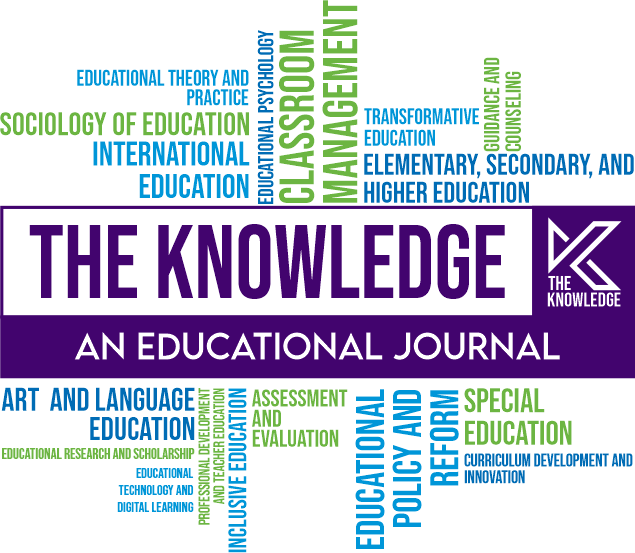From Bullying to Belonging: Teachers' Role in Peace-building in Primary Schools
DOI:
https://doi.org/10.63062/tk/2k25a.41048Keywords:
Bullying, Peace-Building, Primary Schools, Teachers RoleAbstract
Primary schools can be transformed From Bullying to Belonging: Teachers' Role in Peace-building in Primary Schools. By cultivating inclusive classrooms, encouraging empathy, putting conflict resolution techniques into practice teachers may reduce aggressiveness and create constructive peer relationships. Their proactive measures such restorative practices and anti-bullying initiatives, encourages students to value diversity and respect from one another. The purpose of this research was to identify the types of bullying, causes of bullying, effects of bullying and teachers’ role to address and control bullying with effective interventions. In this descriptive research the data was collected through sampling. The population of this study was the teachers of Tehsil Attock. And the sample size of this study consisted of 220 teachers and 10 head teachers. The findings of this study were to explore different types of bullying in different public schools’ system. The social emotional-learning and teacher-led conflict resolution strengthen student’s sense of belonging and substantially reduce bullying incidents. The study comes to the conclusion that offering teachers peace-building training improves school climate, fostering long-term accordance and the welfare of students. Teachers generally think that to create a healthy environment in schools is essential part of students development, mental health and academic achievements.
References
Aki, E. M. (2019). Transforming female aspirations to real presence: The case of higher education in Cameroon. Educational Research and Reviews, 14(2), 56–66. https://doi.org/10.5897/ERR2018.3648
Aleem, S. (2016). Bullying behavior among school students: A review. Indian Journal of Health & Wellbeing, 7(10), 976–981. https://www.i-scholar.in/index.php/ijhw/article/view/134341
Arseneault, L. (2018). Annual research review: The persistent and pervasive impact of being bullied in childhood and adolescence: Implications for policy and practice. Journal of Child Psychology and Psychiatry, 59(4), 405–421. https://doi.org/10.1111/jcpp.12841
Axford, N., Bjornstad, G., Clarkson, S., Ukoumunne, O. C., Wrigley, Z., Matthews, J., Berry, V., & Hutchings, J. (2020). The effectiveness of the KiVa bullying prevention program in Wales, UK: Results from a pragmatic cluster randomized controlled trial. Prevention Science, 21(5), 615–626. https://doi.org/10.1007/s11121-020-01103-9
Baldry, A. C., & Farrington, D. P. (2000). Bullies and delinquents: Personal characteristics and parental styles. Journal of Community & Applied Social Psychology, 10(1), 17–31. https://doi.org/10.1002/(SICI)1099-1298(200001/02)10:1<17::AID-CASP526>3.0.CO;2-M
Bonds, M., & Stoker, S. (2000). Bully-proofing your school: A comprehensive approach for middle schools. Sopris West.
Borgen, N. T., Olweus, D., Kirkebøen, L. J., Breivik, K., Solberg, M. E., Frønes, I., Cross, D., & Raaum, O. (2021). The potential of anti-bullying efforts to prevent academic failure and youth crime: A case using the Olweus Bullying Prevention Program (OBPP). Prevention Science, 22(8), 1147–1158. https://doi.org/10.1007/s11121-021-01254-3
Bosacki, S. L., Marini, Z. A., & Dane, A. V. (2006). Voices from the classroom: Pictorial and narrative representations of children's bullying experiences. Journal of Moral Education, 35(2), 231–245. https://doi.org/10.1080/03057240600681769
Camodeca, M., & Nava, E. (2022). The long-term effects of bullying, victimization, and bystander behavior on emotion regulation and its physiological correlates. Journal of Interpersonal Violence, 37(3–4), NP2056–NP2075. https://doi.org/10.1177/08862605211005052
Chapell, M. S., Hasselman, S. L., Kitchin, T., Lomon, S. N., MacIver, K. W., & Sarullo, P. L. (2006). Bullying in elementary school, high school, and college. Adolescence, 41(164), 633–648. https://doi.org/10.1002/(SICI)1099-1298(200001/02)10:1
Chen, Q., Zhu, Y., & Chui, W. H. (2021). A meta-analysis on effects of parenting programs on bullying prevention. Trauma, Violence, & Abuse, 22(5), 1209–1220. https://doi.org/10.1177/1524838020907659
Cook, C. R., Williams, K. R., Guerra, N. G., Kim, T. E., & Sadek, S. (2010). Predictors of bullying and victimization in childhood and adolescence: A meta-analytic investigation. School Psychology Quarterly, 25(2), 65–83. https://doi.org/10.1037/a0020149
Dixon, R., & Smith, P. K. (2011). Rethinking school bullying: Towards an integrated model. Cambridge University Press. https://doi.org/10.1017/CBO9780511976179
Espelage, D. L., Hong, J. S., Rao, M. A., & Thornberg, R. (2015). Understanding ecological factors associated with bullying across the elementary to middle school transition in the United States. Violence and Victims, 30(3), 470–487. https://doi.org/10.1891/0886-6708.VV-D-14-00046
Evans, C. B. R., Fraser, M. W., & Cotter, K. L. (2014). The effectiveness of school-based bullying prevention programs: A systematic review. Aggression and Violent Behavior, 19(5), 532–544. https://doi.org/10.1016/j.avb.2014.07.004
Fredrick, S. S., Nickerson, A. B., & Livingston, J. A. (2022). Family cohesion and the relations among peer victimization and depression: A random intercepts cross-lagged model. Development and Psychopathology, 34(4), 1429–1446. https://doi.org/10.1017/S095457942100016X
Gaffney, H., Ttofi, M. M., & Farrington, D. P. (2019). Evaluating the effectiveness of school-bullying prevention programs: An updated meta-analytical review. Aggression and Violent Behavior, 45, 111–133. https://doi.org/10.1016/j.avb.2018.07.001
Garandeau, C. F., Yanagida, T., Vermande, M. M., Strohmeier, D., & Salmivalli, C. (2019). Classroom size and the prevalence of bullying and victimization: Testing three explanations for the negative association. Frontiers in Psychology, 10, 2125. https://doi.org/10.3389/fpsyg.2019.02125
Hagan, J. F., Shaw, J. S., & Duncan, P. M. (2017). Bright futures: Guidelines for health supervision of infants, children, and adolescents: Pocket guide (4th ed.). American Academy of Pediatrics.
Hall, W. J. (2017). The effectiveness of policy interventions for school bullying: A systematic review. Journal of the Society for Social Work and Research, 8(1), 45–69. https://doi.org/10.1086/690565
Hester, R. D. (2017). Lack of access to mental health services contributing to the high suicide rates among veterans. International Journal of Mental Health Systems, 11, 47. https://doi.org/10.1186/s13033-017-0154-2
Hickey, G., McGilloway, S., Hyland, L., Leckey, Y., Kelly, P., Bywater, T., Comiskey, C., Lodge, A., Donnelly, M., & O’Neill, D. (2017). Exploring the effects of a universal classroom management training programme on teacher and child behaviour: A group randomised controlled trial and cost analysis. Journal of Early Childhood Research, 15(2), 174–194. https://doi.org/10.1177/1476718X16644637
Hutson, E., Melnyk, B., Hensley, V., & Sinnott, L. T. (2019). Childhood bullying: Screening and intervening practices of pediatric primary care providers. Journal of Pediatric Health Care, 33(6), e39–e45. https://doi.org/10.1016/j.pedhc.2019.07.003
Kaliyadan, F., & Kulkarni, V. (2019). Types of variables, descriptive statistics, and sample size. Indian Dermatology Online Journal, 10(1), 82–86. https://doi.org/10.4103/idoj.IDOJ_468_18
Lereya, S. T., Copeland, W. E., Costello, E. J., & Wolke, D. (2015). Adult mental health consequences of peer bullying and maltreatment in childhood: Two cohorts in two countries. The Lancet Psychiatry, 2(6), 524–531. https://doi.org/10.1016/S2215-0366(15)00165-0
Menesini, E., & Salmivalli, C. (2017). Bullying in schools: The state of knowledge and effective interventions. Psychology, Health & Medicine, 22(sup1), 240–253. https://doi.org/10.1080/13548506.2017.1279740
Moon, B., Hwang, H. W., & McCluskey, J. D. (2011). Causes of school bullying: Empirical test of a general theory of crime, differential association theory, and general strain theory. Crime & Delinquency, 57(6), 849–877. https://doi.org/10.1177/0011128708315740
Nickerson, A. B., Fredrick, S. S., Allen, K. P., & Jenkins, L. N. (2019). Social emotional learning (SEL) practices in schools: Effects on perceptions of bullying victimization. Journal of School Psychology, 73, 74–88. https://doi.org/10.1016/j.jsp.2019.03.002
Olweus, D., & Limber, S. P. (2018). Some problems with cyberbullying research. Current Opinion in Psychology, 19, 139–143. https://doi.org/10.1016/j.copsyc.2017.04.012
Pellegrini, A. D., & Long, J. D. (2002). A longitudinal study of bullying, dominance, and victimization during the transition from primary school through secondary school. British Journal of Developmental Psychology, 20(2), 259–280. https://doi.org/10.1348/026151002166442
Rose, C. A., Espelage, D. L., & Robinson, L. E. (2022). Emerging issues in school bullying research and prevention. In E. M. Anderman & L. S. Anderman (Eds.), Handbook of classroom management (pp. 167–185). Routledge.
Salmivalli, C., Lagerspetz, K., Björkqvist, K., Österman, K., & Kaukiainen, A. (1996). Bullying as a group process: Participant roles and their relations to social status within the group. Aggressive Behavior, 22(1), 1–15. https://doi.org/10.1002/(SICI)1098-2337(1996)22:1
Thornberg, R., & Jungert, T. (2013). Bystander behavior in bullying situations: Basic moral sensitivity, moral disengagement, and defender self-efficacy. Journal of Adolescence, 36(3), 475–483. https://doi.org/10.1016/j.adolescence.2013.02.003
Ulfah, M., & Gustina, E. (2020). Bullying behavior among students. International Journal of Evaluation and Research in Education (IJERE), 9(3), 644. https://doi.org/10.11591/ijere.v9i3.20437




